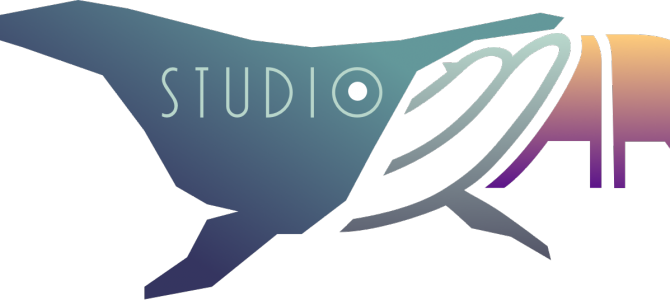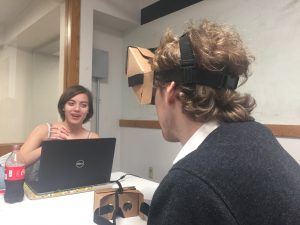This week, Studio Mar focused on creating a playable demo and revising our production schedule, for the prototype presentation on Friday. We also decided on our game name: LineAR (pronounced “linear”)!
FInal Concept
Our final concept is a mobile augmented reality game for two or more players, that is a combination of Pictionary and Charades. One player gets a prompt like “picture frame” or “pirate,” and has to draw that word in 3D space so that the other player can guess it. The fun of playing this game in AR comes from the ability to use the physical space around you, as well as yourself and other players, when drawing. For example, to illustrate the word “trampoline,” you draw a circle on the ground and then jump up and down on it; for the word “sleeve,” your friend draws a sleeve around their arm. This way, the game becomes a kind of Charades with props that you draw yourself.
Extended features
If we have time, we have a few extended features we’d also like to include:
- A gallery of saved drawings overlaid on the real world that you can physically walk through
- Saved drawings are reanimated in the gallery
- Markers on headsets to track and draw on other players
- For example, if you get the prompt “pirate”, you could draw a pirate hat and eyepatch on your friend.
Software: Vuforia + Tilt Brush
After exploring all the technology options, we are moving forward with Vuforia and marker tracking for our software. Unity doesn’t support using more than one AR software at a time, so unfortunately we can’t integrate AR Core or any other AR support with Vuforia. We are still exploring Vuforia’s 3D object tracking and extended tracking, to push the limits of what Vuforia supports and allow for the best play experience that uses the whole room.
We are designing and testing Vuforia markers for the origin marker, the point that allows the drawing to be done in 3D, and allows synchronizing across multiple users; the paintbrush marker, which players use to draw; and the palette marker, which players use to select Tilt Brush paint textures and colors. We are moving forward with using the Tilt Brush SDK for players to have different brush options when drawing.
headset
- Jonathan tests the Holokit’s new headset straps.
- Bobbie and Jonathan discuss the hands-free Holokit headset.
We are continuing to develop for both the Holokit and Google Cardboard, since it is straightforward to make prototypes for both at once. One problem with the Holokit that we discovered during our demo is that the phone camera is placed well above the wearer’s eyes, meaning they have to bend over awkwardly to see something below them that they can see easily without the headset.
Progress update
This week, we:
- Added adjustable straps to the Cardboard and Holokit headsets, so they can be worn hands-free
- Developed multiplayer: multiple players viewing the drawing at once
- Created some palette/non-paintbrush UI design concepts
- Tested Vuforia’s cube targeting: which works pretty well!
- Tested the Merge Cube dev kit
- Made our demo game stereo, so it can be viewed in a headset
We found one major issue with Vuforia’s marker tracking is that it requires the players to keep the origin marker in camera-view at all times, which is awkward, and doesn’t support the use of physical space like we want our game to have. We’ve begun testing potential solutions to the origin marker: a large marker on the wall or the floor, a 3D cylinder or cube marker, and extended tracking.
We also acquired a Google Daydream controller, which we plan on testing to use as a paintbrush controller. We hope that we can use the controller to turn drawing on and off, allowing the user to control drawing multiple strokes, as well as selecting options and increasing brush size. Whichever marker we end up using for the paintbrush would be mounted on top of the controller.
Revised Production Schedule
We updated our production schedule, which is mostly the same as before, but with more consideration for working with markers and UI designs.
| Week 8 / Mar 09 | Multiplayer [Mid-sem break] |
|
| Week 10 / Mar 23 | Alpha |
|
| Week 11 / Mar 30 | Prompts |
|
| Week 12 / Apr 06 | Progress presentation due |
|
| Week 13 / Apr 13 | Brush options |
|
| Week 15 / Apr 27 | Stable release |
|
| Week 16 / May 04 | Final presentation due |
|
Next Steps
Our next immediate steps are:
- Find a better way to track the origin that allows for the use of physical space
- Decide on a paintbrush marker (hopefully 3D, whether cube, cylinder, or other)
- Design UI (what we see in virtual space, without relying on markers)
- Implement multiplayer support
- Test and implement Daydream controllers
- Create a bank of Pictionary-style prompts (test which ones work better in AR)
And, as soon as possible, we want to begin external playtesting, to help build our prompt bank and test the game concept.
Thanks for checking in, and keep checking back for more updates on Studio Mar!



